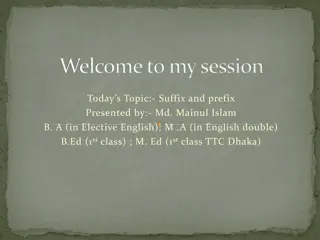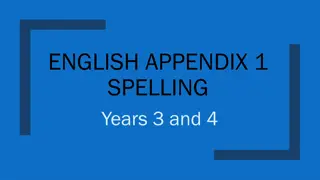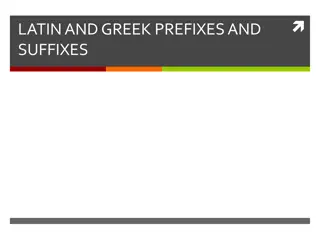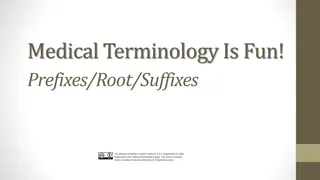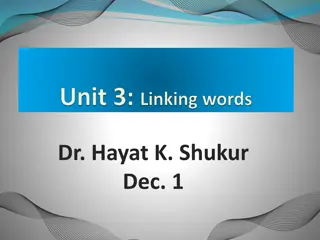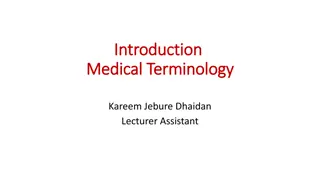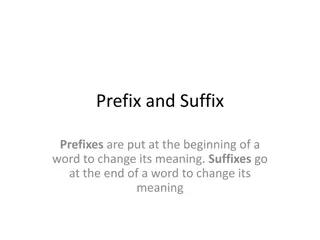Understanding Prefixes in English Language: A Comprehensive Guide
Exploring the significance of learning about Latin and Greek language roots, prefixes, and suffixes in English. Describes prefixes and provides examples to understand their role in altering word meanings. Includes practice exercises and an assessment worksheet to reinforce understanding of prefixes and their usage.
Download Presentation

Please find below an Image/Link to download the presentation.
The content on the website is provided AS IS for your information and personal use only. It may not be sold, licensed, or shared on other websites without obtaining consent from the author. Download presentation by click this link. If you encounter any issues during the download, it is possible that the publisher has removed the file from their server.
E N D
Presentation Transcript
Introduction of Prefixes 7thPeriod Literature 10/22/18 Dr. Germany
Why do we learn about the language the Latin and Greeks used? Many words in the English language come from the Latin and Greek language. The root or base word is the element that gives the basic meaning of a word. Roots often have a prefix or suffix added. Being able to break a word into smaller parts can help you define a word you don't know. English words can be made up of several roots, prefixes, and suffixes.
A prefix is an element added to the beginning of a word. Adding a prefix to a root adds to or alters the meaning of the base word.
prefix example: ant is a prefix meaning opposite ant + onym = antonym onym: is a root meaning name antonym a named word that is opposite in meaning
prefix example: syn is a prefix meaning together or same syn + onym = synonym synonym = a named word that is similar in meaning
Greek and Latin Getting Started Prefix Chart word part definition examples not un unhappy, undo re back repay, replace syn together, same synonym, synchronize frag break fragile, fragment derm skin dermatology, dermatologist
Practice: Exercise A Fill in the blank to complete the sentence: A prefix is the part of the word that goes at the ______of the word. A root is the part of the word that gives _________to the word. The root derm means ________________. Something that is easy to break would be called _____ile. The root __________ means break.
Assessment Prefixes Worksheet (Identifying Part 1) Directions: Circle the word with the prefix in each sentence given below. Example A: My favorite team made it to the semi-finals. Answer: semi-finals 1. I made sure to take the pre-test so I could pass my exam.. 2. I had to re-organize my backpack before coming back to school. 3. We learned about the postmodern era in history class. 4. My parents bought a new automobile this past Sunday. 5. We went shopping for food at the supermarket. 6. The entire school had to wear the new uniforms. 7. I rode my bicycle home from school with my friends. 8. The players went to a pre-game meal. 9. I had to regain my confidence in order to succeed. 10. I went to the post-office to mail my letters. 11. I read a great autobiography by my favorite sports hero. 12. When you play sports, it is important that you eat a pregame meal. 13. I had to re-do my test because I was absent. 14. I watched the postgame show on television. 15. The car I bought was an automatic. 16. One of my favorite heroes is superman. 17. I was taught to never underestimate my opponent
A suffix is an element added to the end of a word. Adding a suffix to a root adds to or alters the meaning of the base word.
Suffix Example derm derm + ology dermatology dermatology is the study of skin is a root meaning skin ology is a suffix meaning study of
Suffix Example ist is a suffix meaning a person who dermatologist = person who studies skin derm + ology + ist = dermatologist
Practice: Exercise B One who makes art is an ________. One who works with chemicals is a ______. One who writes novels is a _____. If bio means life, then the study of life is _____. One who researches or teaches about the study of life is a _______. If cardio means heart, then the study of the heart is _____. One who studies the heart is a _______. Who or what is a dermatologist?
Assessment Circling and Writing Suffixes Worksheet A suffix is a letter or group of letters that is added to the end of a word. Common suffixes include; er, or, ness, ment, ion, ist, ance, or ence. Directions: Circle the word with the suffix in each group of words below. Example: starving, starvation, starve Answer: starvation 1. roof roofs roofing 2. celebrates cheer celebration 3. artist arts art 4. brilliant smart brilliance 5. exciting excited excitable 6. absence absent tardy 7. big bigger large Directions: Look at the suffixes and their meanings below. Write at least one word with each suffix. Then, write a sentence with that word. Example: er- one who Answer: wanderer Sentence: The wanderer found his way home. 8. er: one who- ______________________________ 9. or: one who- ______________________________ 10. ist: one who is an expert in- ______________________________ A suffix is a letter or group of letters that is added to the end of a word.
Reminders: root - part that gives the basic meaning of a word prefix - added to the beginning of a word suffix - added to the end of a word
Practice Find prefix, root, and suffix 1. Unenjoyable 2. Unhappily 3. Predisposal 4. Dishonorable 5. Recommitment
TOTD: Assessment Fill in the blank to complete the sentence: 1. Small and little are words that are similar in meaning. These words are ___. 2. The suffix -itis is added to a root word to mean inflamed or inflammatory disease. Someone who has dermatitis has red, itchy _______. 3. If you drop a glass and it will break into __________, or lots of little pieces.




